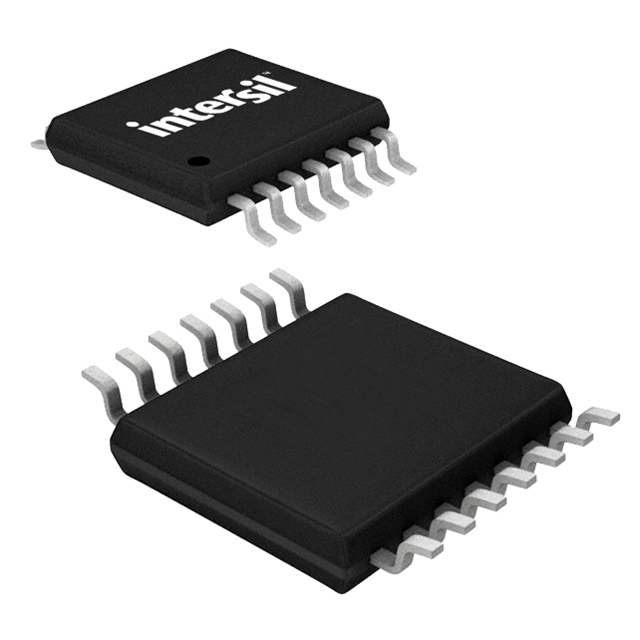Consulte las especificaciones para obtener detalles del producto.

X9428WV14ZT1
Product Overview
- Category: Electronic Component
- Use: Digital Potentiometer
- Characteristics: Programmable, Non-volatile, 10kΩ Resistance Range
- Package: SOIC-8
- Essence: Integrated Circuit
- Packaging/Quantity: Tape and Reel, 2500 units per reel
Specifications
- Resistance Range: 10kΩ
- Number of Taps: 256
- Supply Voltage: 2.7V to 5.5V
- Interface: I2C
- Temperature Range: -40°C to +85°C
- Endurance: 100,000 write cycles
- Data Retention: 100 years
Detailed Pin Configuration
The X9428WV14ZT1 has a standard SOIC-8 package with the following pin configuration:
- VCC: Supply voltage input
- SDA: Serial data input/output for I2C communication
- SCL: Serial clock input for I2C communication
- GND: Ground reference
- WP: Write Protect pin (optional)
- A0: Address bit 0 (for device addressing)
- A1: Address bit 1 (for device addressing)
- H: Hardware address pin (optional)
Functional Features
- Programmable digital potentiometer with non-volatile memory
- Allows for digitally controlled resistance adjustment
- I2C interface for easy integration into various systems
- Low power consumption
- Wide operating temperature range
- High endurance and long data retention
Advantages and Disadvantages
Advantages: - Non-volatile memory ensures resistance settings are retained even after power loss - Precise and accurate resistance adjustment - Easy integration into digital control systems - High endurance allows for frequent resistance changes
Disadvantages: - Limited resistance range (10kΩ) - Requires I2C interface support in the system
Working Principles
The X9428WV14ZT1 is a digital potentiometer that utilizes integrated circuit technology. It consists of a resistive ladder network and a wiper that can be digitally controlled through the I2C interface. The resistance value between the wiper and either end of the ladder can be adjusted by sending appropriate commands via the I2C bus. The non-volatile memory ensures that the resistance settings are retained even when power is removed.
Detailed Application Field Plans
The X9428WV14ZT1 finds applications in various fields, including:
- Audio Equipment: Used for volume control and tone adjustment in audio amplifiers, mixers, and equalizers.
- Industrial Control Systems: Enables precise resistance adjustment in industrial automation systems, motor control, and instrumentation.
- Consumer Electronics: Integrated into TVs, set-top boxes, and gaming consoles for user-controlled settings.
- Automotive Electronics: Used in automotive audio systems, climate control units, and lighting controls.
- Medical Devices: Allows for programmable resistance in medical equipment such as patient monitors and diagnostic devices.
Detailed and Complete Alternative Models
- X9428WV14ZT2: Similar to X9428WV14ZT1 but with extended temperature range (-40°C to +125°C).
- X9428WV14ZT3: Higher resistance range variant (100kΩ) with the same specifications as X9428WV14ZT1.
- X9428WV14ZT4: Dual-channel version of X9428WV14ZT1, allowing independent control of two potentiometers.
(Note: The above alternative models are for illustrative purposes and may not reflect actual product availability.)
This concludes the encyclopedia entry for X9428WV14ZT1, a programmable digital potentiometer with non-volatile memory.
Enumere 10 preguntas y respuestas comunes relacionadas con la aplicación de X9428WV14ZT1 en soluciones técnicas
Sure! Here are 10 common questions and answers related to the application of X9428WV14ZT1 in technical solutions:
Q1: What is X9428WV14ZT1? A1: X9428WV14ZT1 is a specific model or component used in technical solutions, typically referring to a specific electronic device or integrated circuit.
Q2: What are the key features of X9428WV14ZT1? A2: The key features of X9428WV14ZT1 may include high performance, low power consumption, compact size, compatibility with various interfaces, and advanced functionality.
Q3: In which technical solutions can X9428WV14ZT1 be used? A3: X9428WV14ZT1 can be used in a wide range of technical solutions, including but not limited to industrial automation, consumer electronics, telecommunications, automotive systems, and medical devices.
Q4: How does X9428WV14ZT1 enhance technical solutions? A4: X9428WV14ZT1 enhances technical solutions by providing specific functionalities such as data storage, signal processing, control mechanisms, or communication capabilities, depending on its design and purpose.
Q5: Can X9428WV14ZT1 be easily integrated into existing systems? A5: Yes, X9428WV14ZT1 is designed to be compatible with standard interfaces and protocols, making it relatively easy to integrate into existing systems.
Q6: Are there any programming requirements for X9428WV14ZT1? A6: Yes, X9428WV14ZT1 may require programming or configuration to adapt it to specific applications. This can be done using appropriate software tools or development environments.
Q7: What is the power consumption of X9428WV14ZT1? A7: The power consumption of X9428WV14ZT1 depends on its operating conditions and usage. It is typically designed to be energy-efficient, but specific power requirements should be checked in the datasheet or technical documentation.
Q8: Can X9428WV14ZT1 operate in harsh environments? A8: X9428WV14ZT1 may have different variants or versions suitable for different environmental conditions. Some models may be designed to operate in harsh environments with extended temperature ranges, resistance to moisture, or protection against vibrations.
Q9: Is X9428WV14ZT1 compatible with other components or systems? A9: X9428WV14ZT1 is generally designed to be compatible with standard interfaces and protocols, allowing it to work seamlessly with other components or systems that adhere to those standards.
Q10: Where can I find more information about X9428WV14ZT1? A10: More information about X9428WV14ZT1 can be found in its datasheet, technical documentation, or by contacting the manufacturer or distributor directly.

